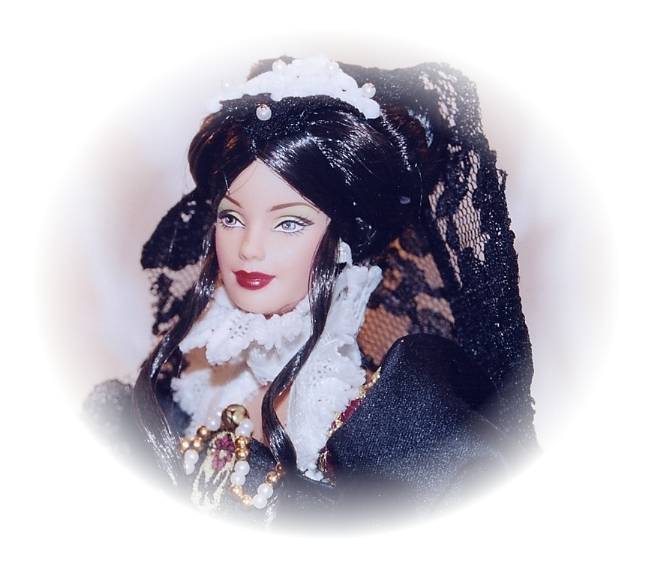 |
 |
 |
|
Ladie Faire Doll Designs
|
 |
 |
 |
|
Home | Medieval/Renaissance Designs | Antebellum "Belles" | Victorian and Edwardian Designs | Other Period Designs | Faerie/Fantasy Designs
|
 |
 |
|
37th OOAK Design:
Dichos el día, dichosa la hora,
tambiné la tierra donde nacer
quiso
ésta del mundo general señora.
Dichosa edad, que tanto se mejora,
pues entre sí ya tienen paraýso
los
que infierno tuvieron hasta'gora.
Happy the day, happy the hour,
also the land where she chose to be born,
this
lady, commander of the world.
Happy the age that so improves,
for they have among themselves a paradise
who until
now had only a hell.
--Juan Boscán Almogáver, c. 1495-1542
|
 |
 |
 |
 |
|
| Leonore |

|
This doll wears the fashion of the late-16th century, a style often called "Tudor," after the English royal house
made famous by Henry VIII of the six wives, and later "Elizabethan" after his daughter, Queen Elizabeth of England.
The basic style of dress, especially the shape and ornamentation of women's clothing was long-lived and fairly standard in
Renaissance Europe with very similar styles extending through the 1500's. The specific elements of this design place it around
1570, contemporaneous with the reigns of Queen Elizabeth in England and Phillip II of Spain. Leonore, is a princess, or infanta,
of the Spanish royal house; her name is a more vernacular Spanish form of Eleanor, which was a favorite female name throughout
the royal houses of Europe. She is not meant to represent an historic personage, but modeled after royal couture in the Spanish
style of this period; this would be a very formal outfit, worn to some state occasion.
|
 |
|
 |
 |
 |
 |
 |
 |
 |
|
| Leonore |

|
I have chosen dark, rich colors for this design, which both complement the doll's coloring and is true to fashion in this
period. The dress is in four parts, all removable: an underskirt, overskirt, bodice and pair of sleeves (normally these would
be separate from the bodice and fastened to it with ties or buttons, but these tiny, snugly-fitting sleeves stay in place
without them). The bodice and overskirt are of glossy black satin. The bodice is fitted and stiff, with the low, straight-across
neckline and dropped, pointed waistline. The overskirt is quite full and sweeping with pleats sewn in at the back and side
for extra fullness, along with extra padding underneath the side of the waist--this gives the basic cone-shape that was imparted
by the "Spanish farthingdale," which was a lattice-like frame worn under the skirt to give it this distinctive shape.
The front of the bodice and the split of the overskirt as accented by a wide, rich ribbon of gold, black and burgundy with
a rose motif; gold and burgundy ribbon-braid trim the hem of the skirt and the sleeves which are poufed at the shoulder and
fitted from elbow to wrist, then finished with white lace. The split overskirt reveals a full underskirt with a gorgeous
rose and wine pattern; it is edged in wine-colored braid.
|
|
 |
|
|
|
 |
 |
 |
 |
 |
 |
 |

| Leonore |

|
Other accessories include jewelry, girdle, headdress, and a veil. Decorating the decolletage of the bodice is a chain of
gold and pearl beads, attached at the shoulders and looped up in the middle through a "pectoral" ornament: basically
a pendant or brooch attached over the chest, here an antique-gold bead with a rose motif. This arrangement came in vogue
in the 1550's and continued through the Elizabethan period. She also wears white, filigreed headdress, by which her sweeping,
floor-length lace veil, or mantilla, is attached to her head with pearl-tipped hairpins.
|
|
 |
 |
 |
|
| Leonore |

|
| Leonore |

|
For more views of this design click on the link below:
More Leonore
|
|
 |
 |
 |







